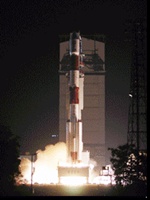ISRO jubilant on launch of India’s first navigation satellite
02 Jul 2013
Prime Minister Manmohan Singh today congratulated scientists of the Indian Space Research Organisation on the successful launch of India's first navigation satellite.
 The satellite was launched on an Indian rocket from ISRO's Sriharikota facility at midnight on Monday-Tuesday and successfully placed in orbit.
The satellite was launched on an Indian rocket from ISRO's Sriharikota facility at midnight on Monday-Tuesday and successfully placed in orbit.
This is the first of seven satellites planned under the Indian Regional Navigation Satellite System (IRNSS), and brings India a step closer to joining the select group of nations with such a system.
K Radhakrishnan, chairman of ISRO, said with the launch of the satellite, India had entered "a new era of space applications".
The Prime Minister described it as an important milestone in the development of India's space programme. "India's space programme is playing an increasingly important role in socio-economic development of the country," he said in a statement.
Exactly at 11.41 pm, the Polar Satellite Launch Vehicle-C22 (PSLV-C22), a rocket standing around 44 metres tall and weighing around 320 tonnes, roared off, turning the dark skies bright orange.
"We have had late evening and early morning launches. But this is the first time ISRO is launching a rocket around midnight," an ISRO official said.
The expendable rocket had a single but important luggage, the 1,425 kg IRNSS-1A navigation satellite.
Blasting off from the first launch pad at the Satish Dhawan Space Centre in Sriharikota, around 80 km from Chennai, to the onlookers, the rocket looked like an inverted flare or torch with a long handle as it ascended towards the twinkling stars amidst the cheers of the gathered scientists and media persons.
The ISRO scientists at new rocket mission control room were glued to their computer screens watching the rocket escaping the earth's gravity. Around 20 minutes into the flight, PSLV-C22 successfully ejected IRNSS-1A, bringing cheers to the mission control centre.
"I am extremely happy we had another excellent flight of our PSLV vehicle," Radhakrishnan said, adding it was the 23rd successful flight of PSLV and 4th of the XL variant, terming it an "extremely reliable vehicle".
Announcing the precise injection of the satellite in its designated orbit, he said, "India has entered a new era of space applications."
Famous scientist Yashpal and Rajya Sabha deputy chairman P J Kurien were also present at the launch.
Soon after the ejection into the orbit the satellite's solar panels were deployed.
The satellite control was taken over by the Mission Control Facility (MCF) at Karnataka's Hassan. The MCF will manage the satellite's orbit raising operations firing the on-board motors till it is placed in the circular geosynchronous orbit.
The IRNSS-1A satellite is intended to provide terrestrial, aerial and marine navigation services and help in disaster and fleet management.
The satellite with a life span of around 10 years is one of the seven satellites constituting the IRNSS space segment - a regional navigational system developed by India designed to provide accurate position information service to users within the country and up to 1,500 km from the nation's boundary line, the ISRO said.













.jpg)






.jpg)









